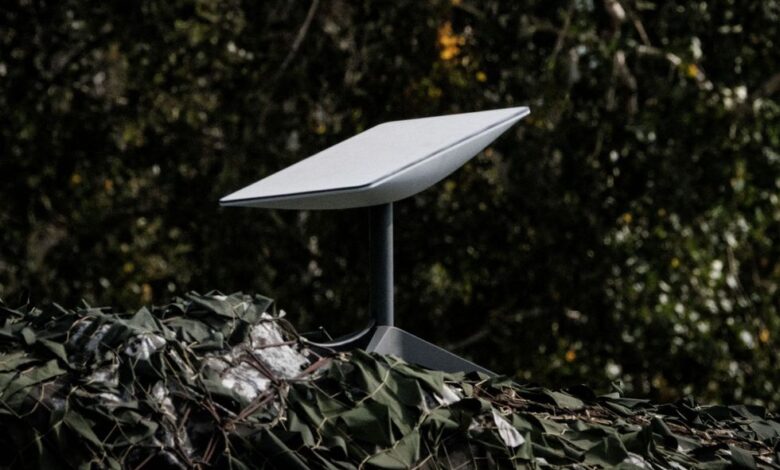Satellite Signal Jamming Reaches New Lows

Russia’s invasion of Ukraine in 2022 put Ukrainian communications in a literal jam: Just before the invasion, Russian hackers knocked out Viasat satellite ground receivers across Europe. Then entrepreneur Elon Musk swept in to offer access to Starlink, SpaceX’s growing network of low-Earth orbit (LEO) communications satellites. Musk soon reported that Starlink was suffering from jamming attacks and software countermeasures.
In March, the U.S. Department of Defense (DOD) concluded that Russia was still trying to jam Starlink, according to documents leaked by U.S. National Guard airman Ryan Teixeira and seen by the Washington Post. Ukrainian troops have likewise blamed problems with Starlink on Russian jamming, the website Defense One reports. If Russia is jamming a LEO constellation, it would be a new layer in the silent war in space-ground communications.
“There is really not a lot of information out there on this,” says Brian Weeden, the director of program planning for the Secure World Foundation, a nongovernmental organization that studies space governance. But, Weeden adds, “my sense is that it’s much harder to jam or interfere with Starlink [than with GPS satellites].”
LEO Satellites Face New Security Risks
Regardless of their altitude or size, communications satellites transmit more power and therefore require more power to jam than navigational satellites. However, compared with large geostationary satellites, LEO satellites—which orbit Earth at an altitude of 2,000 kilometers or lower—have frequent handovers that “introduce delays and opens up more surface for interference,” says Mark Manulis, a professor of privacy and applied cryptography at the University of the Federal Armed Forces’ Cyber Defense Research Institute (CODE) in Munich, Germany.
Security and communications researchers are working on defenses and countermeasures, mostly behind closed doors, but it is possible to infer from a few publications and open-source research how unprepared many LEO satellites are for direct attacks and some of the defenses that future LEO satellites may need.
For years, both private companies and government agencies have been planning LEO constellations, each numbering thousands of satellites. The DOD, for example, has been designing its own LEO satellite network to supplement its more traditional geostationary constellations for more than a decade and has already begun issuing contracts for the constellation’s construction. University research groups are also launching tiny, standardized cube satellites (CubeSats) into LEO for research and demonstration purposes. This proliferation of satellite constellations coincides with the emergence of off-the-shelf components and software-defined radio—both of which make the satellites more affordable, but perhaps less secure.
Russia’s defense agencies commissioned a system called Tobol designed to counter jammers that might interfere with their own satellites, reported journalist and author Bart Hendrickx. That implies that Russia either can transmit jamming signals up to satellites, or suspects adversaries can.
Many of the agencies and organizations launching the latest generation of low-cost satellites haven’t addressed the biggest security issues they face, researchers wrote in one review of LEO security in 2022. That may be because one of the temptations of LEO is the ability of relatively cheap new hardware to do smaller jobs.
“Satellites are becoming smaller. They are very purpose-specific,” says Ijaz Ahmed, a telecoms security researcher at the VTT Technical Research Centre in Espoo, Finland. “They have less resources for computing, processing, and also memory.” Less computing power means less encryption capabilities, as well as less ability to detect and respond to jamming or other active interference.
The rise of software-defined radio (SDR) has also made it easier to get hardware to accomplish new things, including allowing small satellites to cover many frequency bands. “When you make it programmable, you provide that hardware with some sort of remote connectivity so you can program it. But if the security side is overlooked it will have severe consequences,” Ahmed says.
“At the moment there are no good standards focused on communications for LEO satellites.”
—Mark Manulis, professor of privacy and applied cryptography
Among those consequences are organized criminal groups hacking and extorting satellite operators or selling information that they capture.
One response to the risks of software-defined radio and the fact that modern low-cost satellites require firmware updates is to include some simple physical security. Starlink did not respond to requests for comments on its security, but multiple independent researchers said that they doubt today’s commercial satellites match military-grade satellite security countermeasures, or even meet the same standards as terrestrial communications networks. Of course, physical security can be defeated with a physical attack, and state actors have satellites capable of changing their orbits and grappling with, and thus perhaps physically hacking, communications satellites, the Secure World Foundation stated in an April report.
LEO Satellites Need More Focus on Cryptography, Hardware
Despite that vulnerability, LEO satellites do bring certain advantages in a conflict: There are more of them and, per satellite, they cost less. Attacking or destroying a satellite “might have been useful against an adversary who only has a few high-value satellites, but if the adversary has hundreds or thousands, then it’s a lot less of an impact,” Weeden says. LEO also offers a new option: Sending a message to multiple satellites for later confirmation. That wasn’t possible when only a handful of GEO satellites covered the Earth, but it is a way for cooperating transmitters and receivers to ensure that a message gets through intact. According to a 2021 talk by Vijitha Weerackody, a communications engineer at Johns Hopkins University, as few as three LEO satellites may be enough for such cooperation.
Even working together, future LEO constellation designers may need to respond with improved antennas, radio strategies including spread spectrum modulation, and both temporal and transform domain adaptive filtering[xv]. These strategies come at a cost to data transmission and complexity. But such measures may still be defeated by a strong enough signal that covers the satellite’s entire bandwidth and saturates its electronics.
“There’s a need to introduce a strong cryptographic layer,” says Manulis, “At the moment there are no good standards focused on communications for LEO satellites. Governments should push for standards in that area relying on cryptography.” The U.S. National Institute of Standards and Technology does have draft guidelines for commercial satellite cybersecurity that satellite operator OneWeb took into account designing its LEO constellation, says OneWeb principal cloud security architect Wendy Ng: “Hats off to them, they do a lot of work speaking to different vendors and organizations to make sure they’re doing the right thing.”
OneWeb uses encryption in its control channels, something a surprising number of satellite operators fail to do, says Johannes Willbold, a doctoral student at Ruhr University in Bochum, Germany. Willbold is presenting his analysis of three research satellites’ security on 22 May, 2023 at the IEEE Symposium on Security and Privacy. “A lot of satellites had straight-up no security measures to protect access in the first place,” he says.
Securing the growing constellations of LEO satellites matters to troops in trenches, investors in any space endeavor, anyone traveling into Earth orbit or beyond, and everyone on Earth who uses satellites to navigate or communicate. “I’m hoping there will be more initiatives where we can come together and share best practices and resources,” says OneWeb’s Ng. Willbold, who co-founded an academic workshop on satellite security, is optimistic that there will be: “It’s surprising to me how many people are now in the field, and how many papers they submitted.”
IEEE Spectrum




